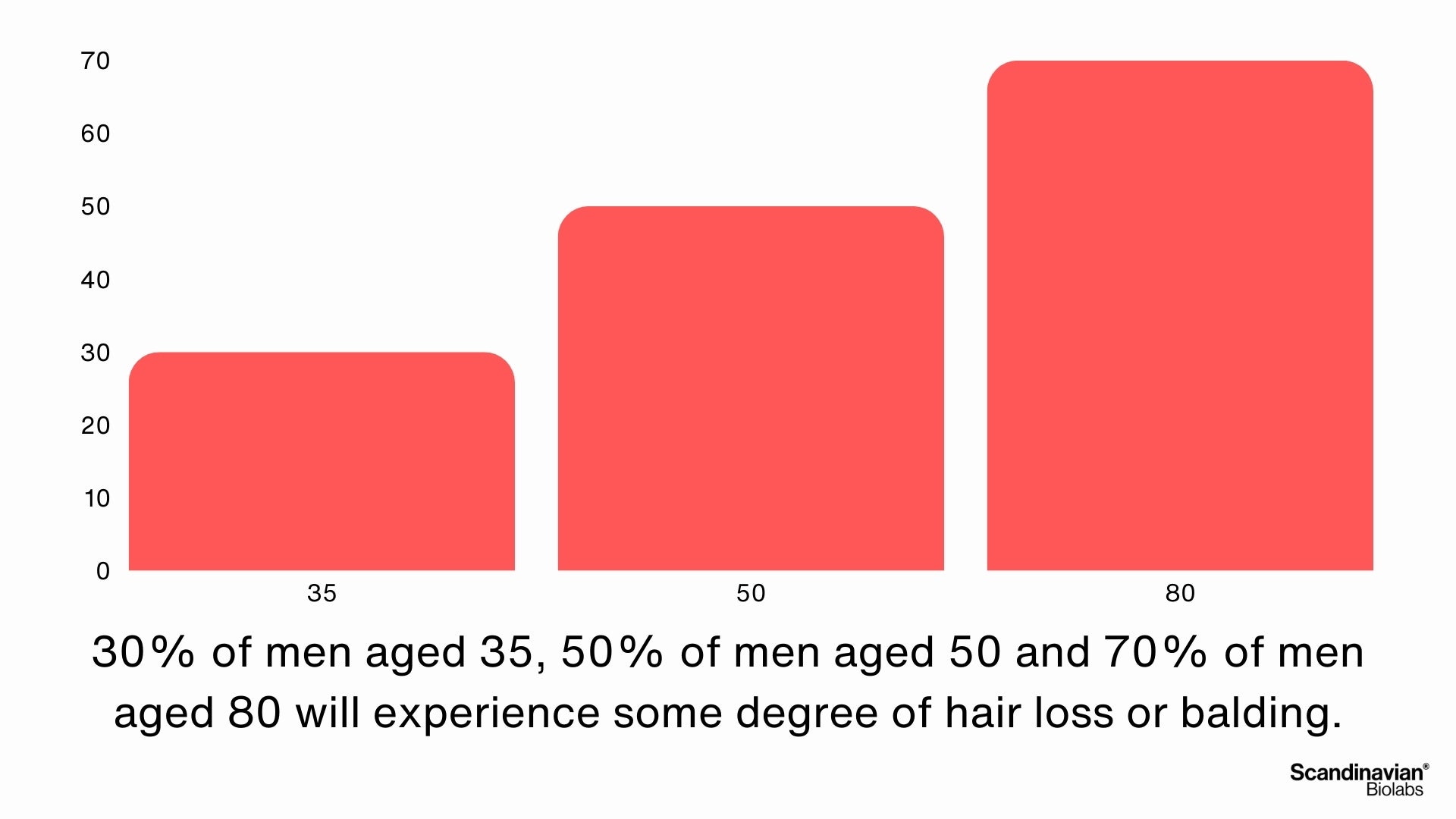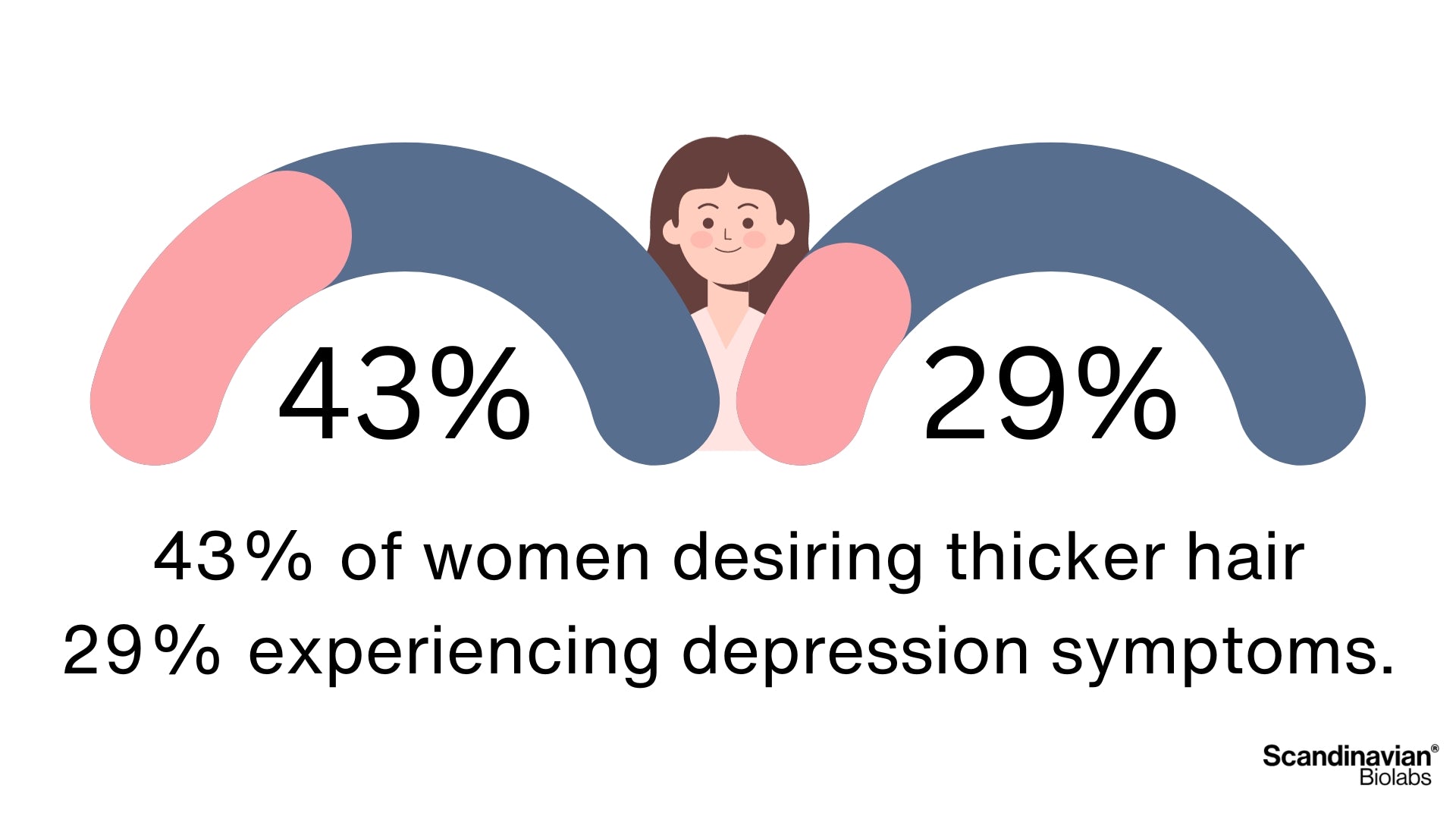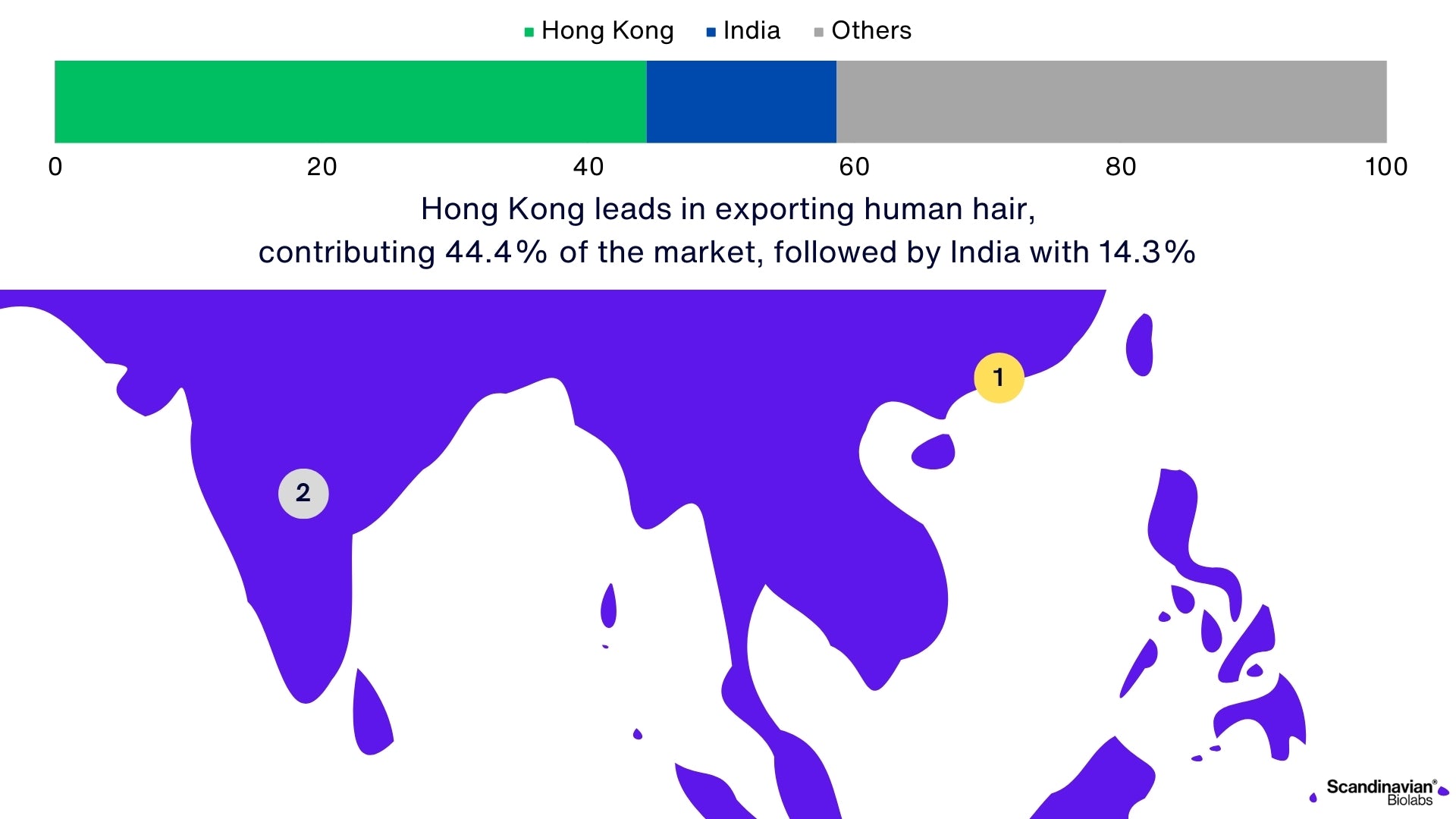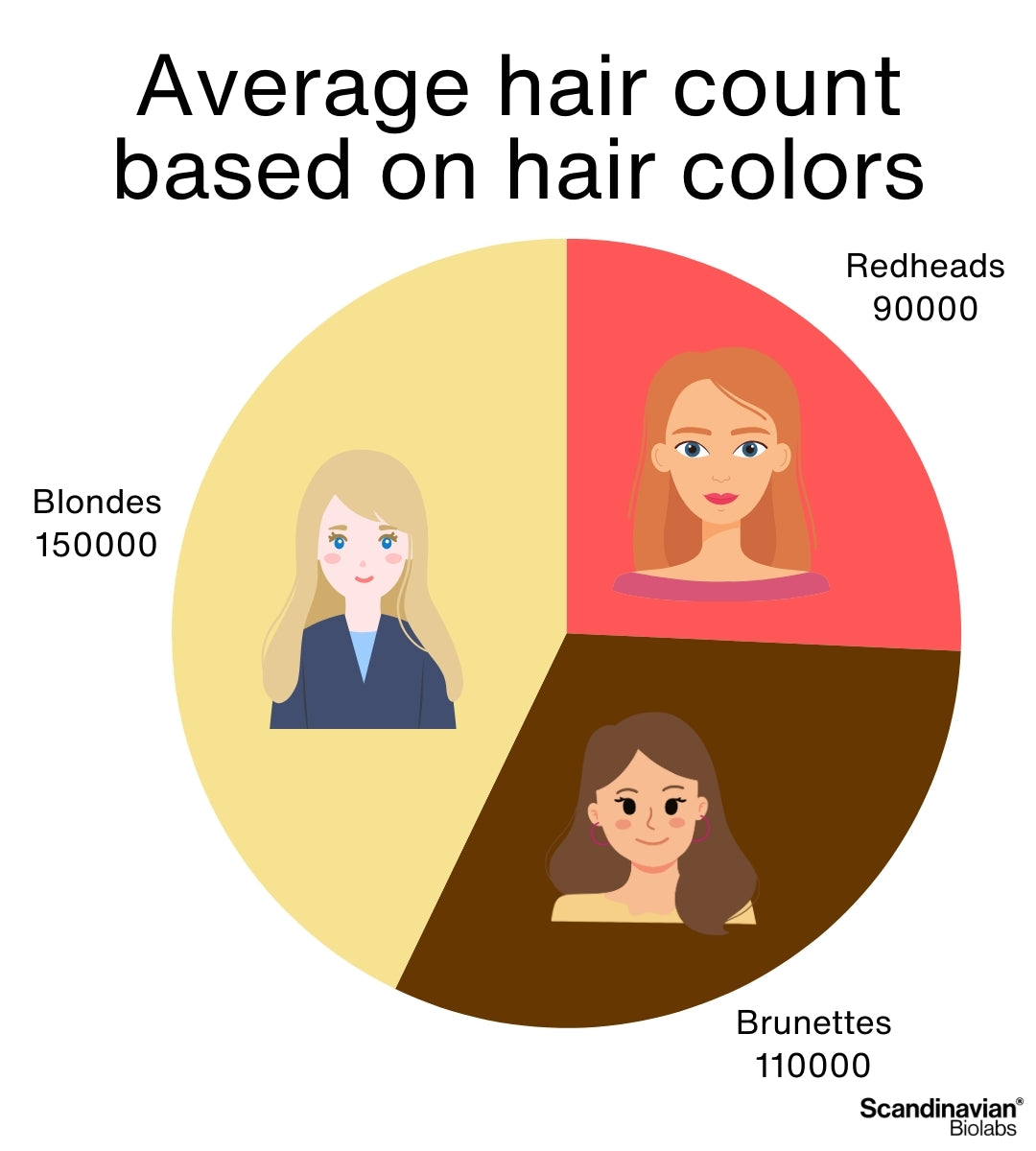These hair loss statistics will shock you: did you know one in two men experience some degree of hair loss by age 50?
In this comprehensive guide, we've compiled an extensive array of hair loss statistics sourced from reputable studies and sources, providing you with a holistic understanding of this common condition in 2025.
Table of content
Key Hair Loss Statistics Of 2025

These are the key, most popular statistics we found on hair loss.
- 85% of men and 33% of women experience hair loss at some point in their lives
- By age 30, 25% of men and 12% of women experience hair loss
- People lose 50-100 hair strands per day
- By age 50, about 50% of men and 25% of women experience significant hair loss
-
The average person has approximately 100,000 hairs on their head
- Approximately 70% of hair loss cases have a genetic predisposition
- By age 35, 66% of men experience significant hair thinning
- Over 56 million people in the U.S. experience hair loss
- The hair loss treatment market was valued at USD 52.37 billion in 2022 and has shown consistent growth:
- 2017: USD 37.84 billion
- 2018: USD 40.65 billion
- 2019: USD 42.95 billion
- 2020: USD 45.28 billion
- 2021: USD 48.76 billion
- 2022: USD 52.37 billion (U.S. market: $18.34 billion, UK market: $3.67 billion)
- Projected to reach USD 88.18 billion by 2030
As your leading source for hair health information over the past 4 years, we never compromise on accuracy. When it comes to your health, you deserve information you can truly rely on - and earning your trust is our top priority.
Here's how Scandinavian Biolabs ensures every piece of content meets the highest standards of accuracy and integrity:
- Credentialed Experts: Our reviewers are actively practicing doctors and medical researchers
- Stringent Reviews: Content undergoes rigorous editing by subject specialists and review by a practicing doctor.
- Evidence-Based: We rely on well-established research from trusted scientific sources like peer-reviewed journals and health authorities.
- Full Transparency: Our editorial standards, writer credentials, reviewer credentials, correction process, and funding are all publicly documented.
- Independent Voice: While we do promote products, we operate in a vacuum to business operations. Our main goal is just an unwavering commitment to providing medically-sound guidance.
You can count on Scandinavian Biolabs to consistently deliver the trustworthy health information you deserve. Read our Editorial Standards.
Timeline of Hair Loss Experience
- 25.66% had hair loss for less than 5 years
- 41.34% had it for 5-10 years
- 33% experienced hair loss for more than ten years
Treatment Usage Statistics
- 66.40% use Finasterid 1mg
- 56.8% use 5% minoxidil foam
- 14.3% use 5% minoxidil
- 14.3% use topical finasteride
- 10.2% use oral minoxidil
- 43.5% have tried platelet-rich plasma
- 32% use vitamins and nutrients
- 27% use biotin
- 25% use ketoconazole shampoo
Men's Hair Loss Statistics
However, according to Patient UK, 30% of men aged 35, 50% of men aged 50 and 70% of men aged 80 will experience some degree of hair loss or balding.

Surprisingly, despite common beliefs, bald men do not necessarily have higher levels of testosterone.

- Androgenetic alopecia is responsible for 95% of male hair loss
- Approximately 25% of men start balding before reaching 21
- By age 35, about 66% of men experience hair loss
- By age 50, roughly 85% of men have significantly thinner hair
- Approximately 70% of men experience hair loss by age 80
- Bald men do not always have higher levels of testosterone
- 63 genes are involved in the development of male pattern baldness
- Drinking sugary drinks linked to greater chance of male pattern baldness in young men
- Many men change their careers due to hair loss
- 26% of men grow a moustache or beard to make themselves feel better about hair loss
- 22% start working out more, and 16% get tattoos to compensate for hair loss
- 72% of people suspect that a man wearing a hat in his dating profile photo is probably bald
- 13% of survey respondents reported canceled dates after revealing baldness
- Only 11% of UK men consult a professional upon initially noticing hair loss
- UK men between ages 25-34 most likely to seek professional advice
- 17% of men use over-the-counter treatments
- Men aged 45-54 more likely to shave heads as initial response
- Males aged 16-24 most likely to pursue hair transplant surgery
- Men report almost double personal satisfaction after hair transplants
- 1.56 times boost in self-esteem after transplants
Women's Hair Loss Statistics
Women also face hair loss challenges, with approximately half of them experiencing it at some point in their lives.
Female pattern hair loss is a common condition, affecting 2-3% of women by the age of 30, and the prevalence increases to about 10% by the time they reach 50.
It continues to affect around 30% of women by the age of 70. Furthermore, about 50% of women begin losing their hair by the age of 50.
These concerns are not just cosmetic; they can have significant emotional impacts, as 43% of women wish for fuller and thicker hair.
In fact, 29% of women with hair loss experience two symptoms of depression, emphasizing the psychological toll of this condition.

Stress is a major factor, as women with high-stress levels are 11 times more likely to experience hair loss.
Additionally, post-menopausal changes can trigger hair loss, affecting half of women after menopause.
- Half of all women experience hair loss at some point in their lives
- Female pattern hair loss affects 2-3% of women by the age of 30
- By age 50, approximately 10% of women are affected by female pattern hair loss
- By age 70, around 30% of women experience female pattern hair loss
- About 50% of women start losing their hair by the age of 50
- 43% of women wish their hair was fuller and thicker
- 29% of women with hair loss report experiencing two symptoms of depression
- Women with high-stress levels are 11 times more likely to experience hair loss
- 50% of women experience hair loss after menopause
- Androgenic alopecia (AGA) impacts around 30% of middle-aged women
- 40% of Americans experiencing hair loss are women
- In the UK, 6% of women under 30 years old experience Female Pattern Hair Loss (FPHL)
- 28.6% of junior high school girls experience FPHL, with higher rates in rural areas compared to urban ones
- 38% of women experiencing hair loss were found to have low biotin levels
- Vegans and vegetarians face a greater risk of Iron Deficiency (ID) since their dietary iron needs are estimated to be 1.8 times higher than those who eat meat
- Between 6% and 38% of healthy women experience hair loss at the front or sides of their heads
- Demand for female hair loss treatment is higher among patients aged 25 to 40 years
- Experiencing periods of rapid hair loss lasting 3–6 months, followed by phases of stability ranging from 6–18 months, is fairly common for women with FPHL
- Hair transplant procedures for FPHL are gaining popularity
- TE (Telogen Effluvium) is reported more frequently in women
- A study on postmenopausal women with female pattern alopecia showed a correlation between the extent of hair loss and body mass index, indicating a possible connection to metabolic syndrome
- Treating female pattern hair loss early with oral antiandrogens and topical minoxidil can successfully stop hair loss from getting worse and help improve mental well-being
- Women are typically advised to use a 2% concentration of Minoxidil, in contrast to the 5% concentration that men often use
Hair Loss Industry Statistics

The hair industry is vast and dynamic, with Hong Kong leading in exporting human hair, contributing 44.4% of the market, followed by India with 14.3%. In the United States, a significant portion of the population uses hair growth products, with 12.42 million Americans using them in 2020, and this number is projected to increase to 12.94 million in 2024. In China, JD.com reported a remarkable 387% increase in hair loss shampoo sales compared to the previous quarter.
- Hong Kong leads in exporting human hair with 44.4%, followed by India at 14.3%
- In 2020, 12.42 million Americans used hair growth products, with a projected increase to 12.94 million in 2024
- JD.com reported a 387% increase in hair loss shampoo sales in China compared to the previous quarter
- By 2027, the Hair Transplant Market is forecasted to reach a value of USD 8,777.56 million
- The market for alopecia treatment in Europe is expected to expand at a CAGR of 6.70% from 2023 to 2030
- A survey involving 346 people from Germany, Austria, and Switzerland revealed that individuals affected by alopecia areata spend an average of 1,248€ annually on related necessities
- 73.7% of respondents in Europe were not pursuing treatment, citing reasons such as ineffectiveness, side effects, costs, and coming to terms with the condition
- Standardized para rubber seed oil is shown to be a safe and effective bio-oil for promoting hair growth or reducing hair loss
- Improving hair loss disorders involves multiple approaches due to their complex causes
- 96.4% of ISHRS hair surgeons reported that up to 25% of their repair cases stemmed from previous black market hair transplants
- 66.2% of worldwide hair transplant surgeries employ the FUE method, 31.5% utilize FUT, and 2.35% combine both techniques
Health & Hair Loss Statistics
Hair loss can sometimes be an indicator of underlying health issues. For example, it can signal potential coronary heart disease risk, depending on its location on the scalp. Furthermore, the emotional toll of hair loss can be compounded for cancer patients, as 65% of them experience hair loss during chemotherapy.
- Baldness can indicate coronary heart disease risk
- 65% of patients experience hair loss during chemotherapy
- 85% of smokers (425/500) exhibit hair loss vs 40% of non-smokers (200/500)
- Hair loss severity among smokers: 47% grade 3, 24% grade 4
- Non-smokers: 20% grade 2, 50% grades 3 or 4
- Earlier onset of hair graying in smokers
- Higher risk of transplant surgery complications for smokers
- Decreased hair oil production starts 45-50 in smokers
- Zinc deficiency hair loss can be reversed
- Vegans/vegetarians face 1.8x higher iron deficiency risk
Children Hair Loss Statistics
Even children can be affected by hair loss, with hair loss-related issues accounting for 3% of pediatric office visits. The psychological impact can be substantial, as 58% of children suffering from alopecia meet the criteria for anxiety disorders.
- Hair loss-related issues account for 3% of pediatric office visits
- 58% of children suffering from alopecia meet the criteria for anxiety disorders
- 28.6% of junior high school girls experience FPHL, with higher rates in rural areas compared to urban ones

General Hair Loss Statistics
Hair, a defining feature for many, is a remarkable part of the human body. On average, a person has 100,000 hair strands, and when healthy and wet, hair can stretch up to 30% in length. Most hair is typically in the growth phase, accounting for 90%, and daily hair shedding of up to 100 hairs is considered normal. Hair grows at a monthly rate of 0.2 to 0.7 inches, but for some, the journey of hair loss can begin as early as age 15, often accelerated by tight hairstyles.
- The average person has 100,000 hair strands
- Hair can stretch up to 30% in length when healthy and wet
- 90% of your hair is typically in the growth phase
- Hair shedding of up to 100 hairs daily is considered normal
- Hair typically grows between 0.2 and 0.7 inches per month
- Hair loss can begin as early as age 15
- Androgenetic alopecia, a hereditary condition triggered by the male sex hormone dihydrotestosterone, is the most widespread type of patterned hair loss globally, beginning after puberty
- Alopecia areata is when the immune system mistakenly attacks hair follicles, leading to bald patches of various sizes
- Tinea capitis, or scalp ringworm, is a fungal infection impacting the scalp and hair shaft. Without early treatment, the affected area can grow and become filled with pus
- If a medication causes hair loss, stopping the drug typically allows hair to grow back normally
Descent-Related Hair Loss Statistics

Hair characteristics can vary significantly among individuals of different ethnicities. Redheads typically have around 90,000 hairs, brown-haired individuals have about 110,000 hairs, and blondes possess roughly 150,000 hairs, on average. Furthermore, hair density varies among ethnicities, with men of African descent having the lowest density, followed by Hispanics and Caucasians. Interestingly, Native Americans seem to be immune to hair loss. Lastly, androgenetic alopecia affects people of different descents in the following order: Caucasians, Asians, Africans, Native Americans, and Eskimos.
- Redheads have approximately 90,000 hairs, brown-haired individuals have around 110,000 hairs, and blondes possess roughly 150,000 hairs, on average
- Men of African descent have the lowest hair density, followed by Hispanics and Caucasians
- Native Americans are virtually immune to hair loss
- People of different descents are affected by androgenetic alopecia in the following order: Caucasians, Asians, Africans, Native Americans, and Eskimos
- In the U.S., hair loss is almost non-existent among Native Americans
- In the Czech Republic, 42.79% of men undergo baldness

US Hair Loss Statistics
The United States has a significant population affected by hair loss, with a total of 56 million individuals experiencing it. This includes 35 million men and 21 million women who are dealing with hair loss challenges.
China Hair Loss Statistics
In China, a staggering 250 million people are currently experiencing hair loss, and among men, 60% have reported hair health problems.
- About 250 million Chinese people are experiencing hair loss
- 60% of men in China have reported hair health problems
- A study in China found a connection between the severity of Androgenetic Alopecia (AGA) and drinking sugary beverages
- A self-reported survey at Tsinghua University found that 60% of respondents claimed to be experiencing hair loss
India Hair Loss Statistics
In India, hair loss is a common concern for men, as approximately 63.2% of Indian men aged 21 to 61 suffer from this condition.
UK Hair Loss Statistics
In the United Kingdom, both women and men are affected by hair loss, with eight million women and six and a half million men experiencing this issue.
- 8 million women in the UK experience hair loss
- 6.5 million men in the UK experience hair loss
- In the UK, 6% of women under 30 years old experience Female Pattern Hair Loss (FPHL)
- In the UK, just 11% of men consult a professional upon initially noticing hair loss
- UK men between the ages of 25 and 34 are most inclined to seek professional advice for hair loss
- Men between 45 and 54 years are significantly more inclined to choose shaving their heads as initial response according to a UK survey
- Males aged 16 to 24 are the most likely to proceed with hair transplant surgery
South Korea Hair Loss Statistics
In South Korea, hair loss is prevalent among male consumers, with 71.8% displaying symptoms of this condition. Nearly 39.8% of Korean men admit to using hair loss shampoo.
- 71.8% of male consumers in South Korea display symptoms of hair loss
- Nearly 39.8% of Korean men admit to using hair loss shampoo
- In South Korea, approximately 39.8% of male consumers acknowledge the use of hair loss shampoo
Hair Loss Perception Statistics
Hair loss can have far-reaching impacts on individuals, affecting not only their self-esteem but also their personal and professional lives. For instance, 40% of women with alopecia report experiencing marital problems, and 63% report career problems. Conversely, when their hair looks great, 81% of women feel confident, and 72% say their hair is empowering. In addition, hair thinning affects a woman's appearance negatively, according to 81% of women. Surprisingly, British men express more fear about losing their hair than losing their jobs.
- 40% of women with alopecia report experiencing marital problems, and 63% report career problems
- 81% of women feel confident when their hair looks great, and 72% say their hair is empowering
- Hair thinning affects a woman's appearance negatively, according to 81% of women
- British men are more afraid of losing their hair than their job
- 13% of individuals in a relationship with someone facing hair loss reported a decline in their partner's confidence
- Many men change their careers due to hair loss
- 26% of men grow a moustache or beard to make themselves feel better about hair loss
- 22% start working out more, and 16% get tattoos to compensate for hair loss
- 72% of people now suspect that a man wearing a hat in his dating profile photo is probably bald
- 13% of survey respondents reported that someone they matched with on a dating app called off a date after discovering they were bald
Hair Transplant Statistics
Hair transplants have become a popular solution for many dealing with hair loss. One out of 13 men has undergone a hair transplant, with 87% of these patients being men and 13% women. The cost of hair transplants varies significantly by country, with Canada having the highest average cost of $17,500 USD, while Turkey offers the lowest average cost at $2,676 USD.
- One out of 13 men has undergone a hair transplant
- Hair transplant patients consist of 87% men and 13% women
- Canada has the highest average hair transplant cost at $17,500 USD, while Turkey has the lowest average cost at $2,676 USD
- More than 90% of the surgical grafts successfully survive in hair transplant procedures
- Men who have undergone a recent hair transplant report almost double the personal satisfaction
- Men experienced a 1.56 times boost in their self-esteem after undergoing hair transplants
- Hair transplant procedures for FPHL are gaining popularity
- By 2027, the Hair Transplant Market is forecasted to reach a value of USD 8,777.56 million
- 96.4% of ISHRS hair surgeons reported that up to 25% of their repair cases stemmed from previous black market hair transplants
- 66.2% of worldwide hair transplant surgeries employ the FUE method, 31.5% utilize FUT, and 2.35% combine both techniques
Smoking Hair Loss Statistics
Smoking can exacerbate hair loss and related issues. For instance, 425 out of 500 smokers showed signs of hair loss, compared to 200 out of 500 non-smokers. Among smokers, 47% had grade 3 hair loss, and 24% had grade 4, whereas 20% of non-smokers had grade 2, and 50% had grade 3 or 4 hair loss. Smokers tend to have an earlier onset of hair graying and a reduced production of hair oil, starting from 45 to 50 years old. Moreover, smokers are at a higher risk of complications during hair transplant surgery.
- 425 out of 500 smokers showed signs of hair loss, compared to 200 out of 500 non-smokers
- 47% of smokers had grade 3 hair loss, and 24% had grade 4 hair loss
- 20% of non-smokers had grade 2 hair loss, while 50% had grade 3 or 4 hair loss
- Smokers had an earlier onset of hair graying
- Smokers are at a higher risk of complications during hair transplant surgery
- Smokers tend to have reduced hair oil production starting from 45 to 50 years old
Source
- https://www.americanhairloss.org/men_hair_loss/introduction.html
- https://www.readersdigest.co.uk/health/medical-myths/medcial-myth-bald-men-have-more-testosterone
- https://publicdocuments.sth.nhs.uk/pil1150.pdf
- https://www.aad.org/public/diseases/hair-loss/insider/shedding
- https://www.aad.org/public/diseases/hair-loss/types/female-pattern
- https://www.ncbi.nlm.nih.gov/pmc/articles/PMC9710406/
- https://www.ncbi.nlm.nih.gov/pmc/articles/PMC4989391/
- https://pubmed.ncbi.nlm.nih.gov/12190640/
- https://pubmed.ncbi.nlm.nih.gov/33185310/
- https://journals.lww.com/jewds/fulltext/2022/19020/hair_loss_in_women.1.aspx




